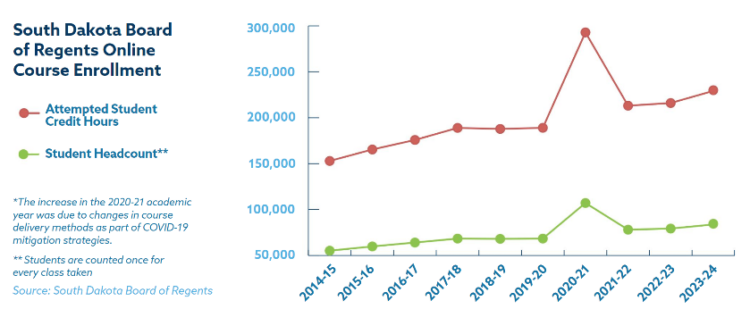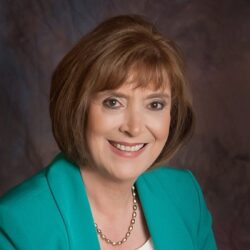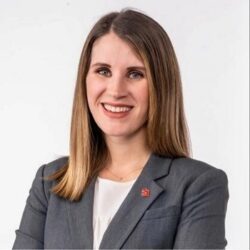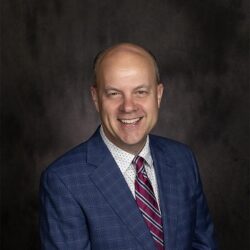
Power in collaboration
How state universities are supporting the Sioux Falls business community
High schoolers graduating today have countless opportunities and options when it comes to what they do next. And while many jobs are available for those looking to go straight into the workforce, South Dakota universities are also doing more than ever to meet students where they are, prioritize innovation and, ultimately, provide the education needed for a diverse and thriving workforce in Sioux Falls.
Sioux Falls may not have its own public university in town, but regional regental institutions have a vested interest in making sure they’re paying attention to South Dakota’s largest city and economic center.
Three of the state’s public universities – Dakota State University (DSU), South Dakota State University (SDSU) and the University of South Dakota (USD) – are within about an hour’s drive from Sioux Falls, which means they’re both attracting local high schoolers to stay in-state and graduating alumni who go on to live and work in the city. And all three of those universities are investing in growing their Sioux Falls presence with programs, facilities, and relationships within the business community.
That means keeping a finger on the pulse of employer needs, said Nathan Lukkes, executive director and CEO of the South Dakota Board of Regents.
“As a public university system, a large part of what we do is ensuring we’re meeting the needs of South Dakota in helping to provide the needed workforce as well as driving our economy forward,” Lukkes said.

Nathan Lukkes
Executive Director & CEO, South Dakota Board of Regents
That goal shows up in a variety of ways, including increasingly flexible delivery options for people seeking higher education. Lukkes said the percentage of credit hours earned from online classes has nearly doubled in the last decade, from 17.5% in the 2013-14 academic year to just over 30% last year.
It’s up to each university to find its own way to meet the needs of employers, workers and the future workforce – something DSU, SDSU and USD have all taken to heart through a variety of existing, new and still-to-come initiatives they shared with Chamber News.
But it’s equally important that the Chamber advocates for strong higher education systems that serve the state’s workforce. The organization does this by voicing support for tuition freezes and numerous capital projects for post-secondary institutions in the Sioux Falls area.
“By continuing to bolster our post-secondary education systems in South Dakota, these institutions in turn continue to provide quality education to our residents and prepare them to hit the ground running as productive members of the community’s workforce,” said Mitch Rave, vice president of public policy for the Chamber.
To know how universities are meeting business needs, it helps to know where their graduates end up. With South Dakota universities, that answer depends significantly on where students were from before they enrolled.
Students who grew up in South Dakota or are residents of the state when they enroll in college are way more likely to stick around and get a job in-state after they graduate. About 73% of resident students are employed in the state post-graduation.
Out-of-state students are less likely to stick around, with about 28% of non-resident students taking jobs in South Dakota after they graduate. That said, the number of non-resident students who decide to work in-state is increasing, Lukkes said. Four years ago, the rate was 23%.
“In real numbers, that’s about 150 students a year more from where we were four years ago,” he added.

Creating space for innovation
It’s no accident that more students are sticking around after graduation. Universities in recent years have taken a more focused approach to ensuring their alumni have opportunities to use their degrees.
Perhaps the most visible recent example of this is the new, 100,000-square-foot cyber-research facility in northwest Sioux Falls from DSU. The building broke ground this spring, and likely won’t be completed until 2026.
When it’s done, though, it’s expected to create a cybersecurity hub for between 400 and 500 workers – including those who need strict security protocol that’s not otherwise accessible in the region. DSU President José-Marie Griffiths said that’ll create a ripple effect of economic impact, estimating that for every one cybersecurity or high-tech job created in Sioux Falls, the community will eventually hire six more people. That includes creating space for graduates to innovate, research and, potentially spin off their own companies based on what they discover.

Dr. José-Marie Griffiths
President, Dakota State University
“We are going to need more people in the cyber world, and we think we could become a regional hub for expertise,” Griffiths said, noting that if the first building is successful, she sees potential for an entire cybersecurity research park.
Similar work is happening in the biotech space out at the USD Discovery District, an 80-acre research park in northwest Sioux Falls. Construction on the first building project is underway, and the resulting 84,000-square-foot multi-tenant research, office and manufacturing space is expected to be completed in January 2025.
Collaboration over competition
With a total of six public universities in a state with fewer than one million residents, it would make sense to see some serious competition between regental universities. However, instead each university has found its own niche in higher education. And even in areas where the same program is offered in different places, there’s a strong sense of collaboration.
In some cases, that collaboration comes about because the needs of the workforce are so great no one university can solve them alone. That’s especially true when it comes to the healthcare industry.
“The shortages that Sioux Falls is experiencing in nursing and other healthcare professions are so daunting that it truly takes all of us in order to meet those needs,” said Alissa Matt, assistant vice president of external relations for USD.

Alissa Matt
Assistant Vice President of External Relations, University of South Dakota
In other cases, universities will even work together or communicate about educational programs they’re adding. SDSU, for example, recently added a new accounting program in the Ness School of Management and Economics, and there were conversations between SDSU and USD as that program was coming together, said Vernon Brown, associate vice president for external affairs.
In addition to collaborating with one another, universities have also formed strong partnerships within the broader Sioux Falls community – including with local K-12 schools, community organizations like Startup Sioux Falls and, of course, groups like the Chamber.
“I think you have to be a participant in the community in order to fully understand it,” Griffiths said.
Meeting students where they are
Having a presence in Sioux Falls is a priority for all three universities not only because it’s the home of many businesses in the state, but also because a large segment of students are here.
“Our charge as a public university is to educate and support workforce needs in South Dakota,” Matt said. “We need to be where those future learners are, and that is in Sioux Falls.”
Increasingly, post-secondary students are looking for flexibility, especially when it comes to meeting the needs of people who are already in the workforce and looking to upskill. That can look like more online class offerings, a growing demand among South Dakota students.
It can also look like more unique class delivery options. Universities are increasingly adding options for micro-credentials, certificates and other options for those who need further education without necessarily needing a full four-year degree. Lukkes said. They’re also working to make it as easy as possible for students to roll those credentials into their next step. If a person with a two-year degree from a technical college wants to pursue a four-year degree, for example, the regents want to make sure they’re making it as seamless as possible to move up to that next step.
Additionally, universities are offering more options for self-paced learning and module-based delivery that allows students to take the course at their own pace and on their own schedule.
“There are many more options today than the traditional, brick-and-mortar, butts-in-seats delivery method,” Lukkes said.

Vernon Brown
Associate Vice President for External Affairs, South Dakota State University
Starting them young
Universities are also helping to meet workforce needs of the future by showing today’s youth the options available to them.
That starts as young as fourth grade, with opportunities for kids to experience science, technology, engineering and math (STEM) fields with DSU’s help, for example.
SDSU also partners with the Sioux Falls School District to help all eighth graders have an opportunity to visit a college campus. Last year, the university hosted 1,500 of Sioux Falls’ 1,800 eighth graders through a variety of visits and partnerships with local nonprofit Promising Futures Fund.
“We’ve got to make sure all families see there are paths available,” Brown said.
USD has also seen success with its teacher pathway program – an effort to let students begin training for a future career in education while still in high school.
For high schoolers, all three universities also offer dual-credit courses, which allow them to earn both high school and college credit simultaneously, giving them a head-start after they graduate.
The Sioux Falls School District will also be part of a new program the Board of Regents is piloting this year to encourage more kids to think about post-secondary education. They’re calling it the “Fast Track for Admissions” program, and essentially it’ll be a direct admission for students who meet certain criteria.
“We’re looking at this program as a way to proactively reach out to those students and let them know, ‘Hey, you have what it takes, and based on your transcript, you’re admitted to university,’” Lukkes said.
Looking toward the future
All three regional state universities have big plans on the horizon to continue to innovate and meet Sioux Falls’ workforce needs.
That includes new physical spaces – from the USD Discovery District to the DSU cyber research labs to a new SDSU Metro Center at the corner of 33rd Street and Minnesota Avenue that will house health sciences, pharmacy, nursing, lab tech and other healthcare programs.
Additionally, universities are looking to help people gain additional skills for a changing workforce, as well as creating opportunities for the future workforce.
USD already offers opportunities for people to take in-person college courses on a flexible schedule at their Sioux Falls campus, which has seen increasing enrollment since the university took leadership of the facility two years ago.
Meanwhile, DSU has been on the forefront of developing programs related to quantum computing, a cutting-edge technology.
“You’re not really coming (to DSU) to study today,” Griffiths said. “You’re coming to study the future.”
And SDSU is on the precipice of becoming South Dakota’s first “Research 1” university. It’s sort of like the academic equivalent of “Division 1” in the sports world, Brown said.
“We’re one of only five states in the nation that doesn’t have a Research 1 university,” Brown said. “It’s about economic development for the state.”
Complementing all of this work is a new merit-based funding opportunity for South Dakota students – the Freedom Scholarship – which Lukkes said is addressing one of the largest barriers people face in getting into the postsecondary world: money.
In the 2022-23 academic year, the most recent data available, the Freedom Scholarship awarded more than $5 million to more than 1,300 students. Each of those students signs a commitment to stay and work in South Dakota for at least three years after they earn their degree.
And, if history is any indicator, many of those graduates will end up in Sioux Falls.